Other articles you would like: Small Non-Shedding Dog Breeds and Is Animal Breeding Safe?
How Much Do Aussiedoodles Shed?
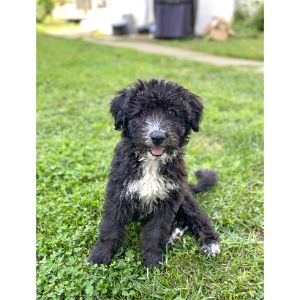
So do Aussiedoodles shed? Yes, Aussiedoodles shed, but they’re considered a low-shedding breed. Their coat is typically a mix of the Poodle’s and the Australian Shepherd’s, meaning it’s usually on the curlier side.
Because of this, their shedding isn’t as noticeable as it would be with a straight-haired breed. On average, Aussiedoodles shed about 6-8 pounds of hair annually.
However, this can vary depending on the individual dog’s coat type and length. Some Aussiedoodles may shed less than this, while others may shed more.
To help keep your Aussiedoodle’s shedding under control, brush them regularly and give them regular baths. You can also use special shampoos and conditioners made for low-shedding dogs.
What Causes Aussiedoodles To Shed?
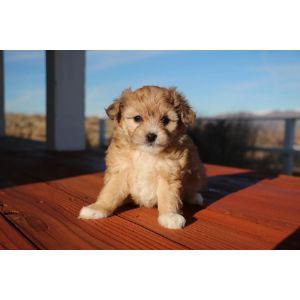
Have you ever asked yourself, “does my Aussiedoodle shed too much?” Like all dogs, Aussiedoodle shed. But there are a few reasons why Aussiedoodles may shed more than usual.
Exposure To Allergens
Aussiedoodles can be prone to allergies, which can cause them to shed more. Allergies can cause various symptoms in dogs, including:
- Itchiness
- Redness
- Bald spots
If your Aussiedoodle is constantly scratching or seems to be in discomfort, it may be time to take them to the vet.
Allergies can be caused by environmental allergies, such as pollen or dust, food allergies, and even reactions to certain medications. Once the vet has diagnosed the allergy, they’ll recommend the best course of treatment.
In some cases, this may involve changing the dog’s diet or giving them medication to relieve the symptoms.
Seasonal Changes
Seasonal changes can be difficult for our furry friends. As the weather starts to cool off, many dogs shed their summer coats in preparation for the winter. The process usually starts occurring when daylight hours decrease.
For Aussiedoodles, this can be especially pronounced due to their double-coated hair. To help your dog through this time of year, brush them regularly and give them plenty of attention.
You may consider using a pet-safe winter coat or sweater to help keep them warm during the colder months.
Diet
Aussiedoodles are a relatively new breed of dog, so there’s still much to learn about their care and nutrition. However, diet can play an essential role in maintaining a healthy coat.
Aussiedoodles require a balanced diet with plenty of protein, fat, and carbohydrates. However, they also need specific vitamins and minerals to support their coat health.
For example, zinc and biotin are essential for healthy skin and hair, while omega-3 fatty acids help to keep the coat soft and shiny.
By ensuring that your Aussiedoodle gets all the nutrients they need, you can help to prevent dry, brittle hair that’s more likely to shed.
Stress
Aussiedoodles can suffer from stress-related shedding like any other dog. When the body is under stress, it releases the hormone cortisol. The hormone helps regulate metabolism and enables the body to deal with stressful situations.
However, it can also cause the Aussiedoodles to shed. This shedding can sometimes be severe enough to cause bald spots.
If your Aussiedoodle is shedding excessively, it may indicate a problem. Stress can negatively impact physical and mental health, so reducing your dog’s stress levels is vital. It may include providing more exercise, socialization, and attention.
If the problem persists, consult with a veterinarian.
How To Minimize Aussiedoodle Shedding

If you have an Aussiedoodle as a pet, you may be wondering how you can minimize shedding in your home. Fortunately, there are some things you can do to help reduce the amount of hair your dog sheds.
Dietary Changes
Aussiedoodles are known for their abundant energy levels and their beautiful coats. This breed requires a lot of exercises to stay healthy and happy, but they also need a quality, well-balanced diet to maintain their coat.
A diet rich in omega-3 fatty acids is essential for keeping an Aussiedoodle’s coat healthy and reducing shedding.
Omega-3 fatty acids help to nourish the skin and hair, and they also have anti-inflammatory properties that can help to reduce shedding.
In addition, a well-rounded, nutrient-dense diet will provide the nutrients that an Aussiedoodle needs for overall health and vitality. When choosing a food for your Aussiedoodle, look for a formula that contains plenty of omega-3 fatty acids.
Regular Brushing
All dogs need basic grooming, including regular brushing to remove dead hair and dirt. But dogs with double coats, like the Aussiedoodle, require more care to prevent matting and keep their coats healthy.
Double-coated dogs have a top coat of longer, coarser hair and an undercoat of shorter, softer hair.
The undercoat insulates the dog against cold weather and repels water, while the top coat protects it from the elements. To prevent matting and keep their coat in good condition, Aussiedoodles need to get brushed regularly.
Use Gentle Detergents And Shampoos
If you’re the proud owner of an Aussiedoodle, you know that maintaining their coat is essential to keeping them feeling and looking their best.
But with so many shampoos and soaps on the market, it can be tough to know which products are safe for your pup. The best shampoo for Aussiedoodles is one free from harsh chemicals or detergents.
These can strip away the natural oils in your dog’s coat, leaving their skin dry and irritated. Instead, look for shampoos and cleaners that are specifically designed for dogs. These products will be gentle on your pup’s coat.
Avoid Over-Bathing Your Aussiedoodle
Although Aussiedoodles don’t require as much grooming as some other breeds, it’s still important to take care of their coat to prevent dryness and excessive shedding. One way to do this is to avoid over-bathing them.
Bathing removes the natural oils in their coat, which can lead to dryness and irritation.
Only bathe your Aussiedoodle when necessary using a mild shampoo designed specifically for dogs. Doing this will help to keep their coat healthy and prevent any problems down the road.
Invest In a Quality Vacuum Cleaner
While regular brushing can help to minimize the amount of hair your dog produces, there’s no way to stop the shedding process completely. As a result, vacuuming is essential for keeping your home clean and hair-free.
However, not all vacuum cleaners are created equal. You’ll need a vacuum with powerful suction to effectively pick up all your Aussiedoodle’s hair.
Fortunately, there are many high-quality options on the market today. With some research, you can find the perfect vacuum for your needs.
Regular Exercising
Regular exercise is essential for maintaining a healthy weight and preventing behavioral problems. However, exercise is also crucial for regulating a dog’s shedding.
Aussiedoodles are known for their high energy levels and dense fur coats. Without enough exercise, these dogs are more likely to shed excessively.
A few easy ways to help reduce shedding include taking your Aussiedoodle on regular walks, runs, or play sessions. These activities will help burn off excess energy and keep shedding to a minimum.
Additionally, ensuring your dog has access to plenty of toys and chew bones will help keep them distracted and prevent them from getting bored.
Use a Shedding Supplement
Anyone who owns a shedding dog knows that hair can quickly become a nuisance. Aussiedoodles are no exception; their thick coats can shed heavily throughout the year.
If you’re constantly sweeping up hair, you may consider using a shedding supplement or coat conditioner.
These products can help to reduce shedding by keeping the coat healthy and hydrated.
There are many different brands on the market, so be sure to talk to your veterinarian about which one would be best for your Aussiedoodle. With regular use, you should significantly reduce the amount of hair around your home.
Frequently Asked Questions About Aussiedoodles Shedding

When you own a dog, you have to expect it to shed. However, when it comes to Aussiedoodles, the amount of shedding they do can be a bit of a surprise for first-time owners.
Here are some of the most common questions people have about Aussiedoodle shedding.
How Often Do Aussiedoodles Shed?
Aussiedoodles shed year-round, but the amount of shedding varies based on the breed and time of year. Some breeds shed heavily, while others only shed lightly. Seasonal shedding is also common in most dogs.
What Causes Aussiedoodles Shedding?
There are numerous reasons why dogs shed. The most common cause is the change in seasons. Dogs shed more during the spring and fall as their coat adapts to the changing temperature and daylight hours.
Other causes of shedding include stress, poor nutrition, and health problems.
How Can I Reduce Shedding?
Regular brushing is the best way to reduce shedding. A consistent grooming routine helps remove loose hair and prevents mats and tangles from forming.
You can also try using a shedding shampoo or conditioner on your dog. If shedding is excessive, speak to your vet.
What Are The Best Brushes For Aussiedoodles That Shed?
The best brushes for Aussiedoodles depend on the coat type. A bristle brush or a slicker brush is typically best for short coats. For long coats, a comb or de-shedding tool may be necessary.
Be sure to choose a comfortable brush for both you and your dog.
Do Mini Aussiedoodles Shed?
Do mini Aussiedoodles shed? Just like their larger counterparts, Mini Aussidoodles will shed seasonally. Since they are smaller, you can expect less shedding.
Can I Stop My Aussiedoodles From Shedding?
It’s impossible for your Aussiedoodles to completely stop shedding, but you can reduce the amount of hair shed by following the tips above. If shedding is excessive, speak to your veterinarian about possible causes and treatments.
As we’ve learned, Aussiedoodles shed, but the amount of shedding varies depending on the coat type of the individual dog. Some Aussiedoodles may only lose a little hair, while others may lose quite a bit.
But with proper care, you should be able to control the amount of your dog’s shedding.
Conclusion For “Do Aussiedoodles Shed?”

Do Aussiedoodles shed? Like most dog breeds, Aussiedoodles shed for various reasons. The primary reason for Aussiedoodle shedding is seasonal changes. But shedding may also be caused by health issues, an unbalanced diet, and stress.
Some shedding is normal, but if you notice your Aussiedoodle shedding more than usual, reach out to your vet.
You will also like:
- Aussiedoodle Breeders in Illinois
- Aussiedoodle Breeders In Virginia
- Aussiedoodle Breeders In Maryland
For more information about Aussiedoodle Shedding, check out the video below:
Rabbits make cute pets, and if you already have a male and a female, you might feel inclined to breed them. It’s not too difficult to breed pet rabbits, but it takes a lot of patience. Read on to learn how to breed rabbits and what to consider when you embark on this task.
Other articles you would like: How To Breed Pet Birds? and How To Make Dogs Breed Successfully.
Getting Started With Breeding Pet Rabbits

When breeding rabbits, there are specific ways you should do things to ensure it goes smoothly.
Females are territorial, so you don’t want to bring a male to her cage to mate. She’s more likely to attack the male instead of mating with him. For rabbits with separate houses, you should always take the female to the male to mate.
You can ensure the rabbit’s mate by watching their actions. If the female is willing to mate, she lifts her tail. The male sees this signal and mounts her. He falls off when he finishes. Allow them to do their business several times before you take the female back to her cage.
Mating stimulates the female rabbit’s ovulation, so you should mate them again after about ten hours. This repetition makes it more likely that she’ll get pregnant and give birth to a large litter of bunnies.
You must observe when the male and female are together because they won’t always mate. Sometimes the female isn’t ready. Rabbits like dogs and cats don’t go into heat, so you never know when they’re ready to mate. You’ll have to try several days in a row if they don’t mate when you first put them together.
Things To Consider
People use the phrase “breed like rabbits” to imply something multiplies quickly, but that isn’t always the case. You might find yourself waiting for your rabbits to mate, and then you’ll have to wait even longer to see if the female is pregnant.
You shouldn’t mate rabbits that are siblings. That’s inbreeding and can lead to genetic problems and illnesses that impact your rabbit’s quality of life.
Knowing the best ways to encourage your rabbits to breed can help speed up the process. If your rabbits aren’t breeding, ensure you have everything right. When they feel healthy and comfortable, they’re more likely to mate.
Why Won’t Rabbits Breed?

Since you don’t know when rabbits want to mate, it’s hard to know why they’re not breeding. Sometimes they’re just not into it, but it might happen if you put them together for several days in a row. If you keep putting them together and they won’t breed, make sure you have all the conditions just right.
Temperature
Rabbits won’t mate when it’s too hot outside. The act gets their blood pumping and will heat them even more, so it’s a lot of effort. Extreme heat can also cause males to go sterile temporarily. If you live in a hot climate, they might even stay sterile for the three months of summer.
For rabbits, anything above 85 degrees is too hot for pregnancy. Even if they mate in the heat, you’re unlikely to get a litter of rabbits from the process.
Light
Rabbits are sensitive to daylight-like humans and chickens. They need a certain amount of light to trigger their circadian rhythm and get enough sleep. If they’re in the dark too much, they can feel depressed. As with humans, you can offset this feeling by using artificial light to stimulate them.
Add a light near their rabbit hutches in seasons when the day isn’t 12 hours long. The additional hours of light will help them feel healthier and get enough rest. As a result, they’ll feel more inclined to breed.
Weight
Overweight rabbits won’t mate because they’re infertile. You can change their diet and give them plenty of room for exercise to help them reach a healthy weight. They’re more likely to want to breed at that point, and those matings are more likely to lead to litters of bunnies.
Litter Spacing
Professional rabbit breeders keep a schedule for litters. They won’t breed a female rabbit who had a little less than 21 days ago. She needs time to nurse them, and breeding her again too quickly can lead to reproductive problems. She might have a smaller litter, or more bunnies might die because she has more than she can handle.
If you leave them alone, the babies wean from the mother by the time they’re four weeks old. You can then breed the mother again if you’re ready for another litter of rabbits.
Waiting too long between litters can also impact the likelihood that your rabbit gets pregnant. Once they’re out of practice, inspiring them to mate and have another litter can be hard. Keeping a schedule can help you take advantage of your rabbits’ health and youth.
How Can You Tell if Your Rabbit Is Pregnant?

Female rabbits won’t always get pregnant after mating. As previously mentioned, mating encourages ovulation, so the first time isn’t always enough. After several days of mating, you might still not know if your rabbit is pregnant.
A rabbit’s pregnancy lasts about 31 to 33 days. You might notice the female has a round belly close to the end of her pregnancy. Keeping track of when you breed your rabbits can help you track a pregnancy. Weight gain isn’t always noticeable, though, so some rabbit owners get a surprise when they see their rabbits having babies early one morning.
Sometimes it’s easier to tell your rabbit is pregnant by watching her behavior. She might not want you to hold her as much as before. She might also experience mood swings and react harshly to any rabbits that live with her.
She’ll pull fur from her body to line a nest for the litter. This step usually happens just a few hours before she gives birth, so you’ll have to watch it late at night. Litters are often born in the early morning. The birth only takes 15 minutes, so you’ll want to keep an eye on the rabbit if you think she’s pregnant, or else you’ll miss it.
You can take your rabbit to the vet to determine if she’s pregnant. The babies are about the size of a grape two weeks after a successful mating. The vet can also give you an idea of how many babies she might have. Small breeds of rabbits usually have four or five babies per litter. Larger breeds can have eight to 12 babies at once.
While it’s possible for you to feel the babies in the rabbit’s belly yourself, it’s dangerous. An inexperienced hand can harm the baby and the mother, so leave that to your vet. If you don’t want to take her to the vet, you can just wait and see if she gives birth.
Female rabbits can experience pseudopregnancy. They might breed with a sterile male or didn’t complete the mating process after the mounting. The action still causes a physiological response where the female feels pregnant. She’ll build a nest for her babies, even though she’s not pregnant.
A pseudopregnancy can last up to 17 days. During this period, the female won’t mate with another male because she thinks she’s pregnant. There’s nothing wrong with the pseudopregnancy period, but it will delay your chance of breeding your rabbits. You have to wait until the female realizes there are no babies and she’s ready to mate again.
How Old Do Bunnies Have to Be to Breed?
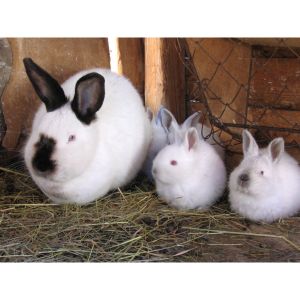
Small breeds of bunnies reach sexual maturity by the time they’re four or five months old. Larger breeds mature at anywhere from five to eight months of age. If your male and female rabbits live together, you should know that they can mate when they’re just a few months old.
While newborn bunnies can live together with no problem, you might want to separate them when they’re a month or two old. You also need to keep a male away from a litter of rabbits because he will try to mate with them.
The mother can stay with the babies to care for them, but the male must stay away from her. He’ll try to mate when she’s not ready for another litter.
Is Breeding Pet Rabbits Profitable?

Breeding pet rabbits is profitable, but it’s not a get-rich-quick scheme. It takes patience to breed rabbits so they and the offspring remain healthy.
Though it can be tough to consider, you should also know that not all rabbits are pets. You can also sell their meat and pelts for profit. If any babies die after birth, you can sell them to pet stores as snake food.
You can also make money from rabbit manure. It’s rich in nitrogen, so gardeners love using it in flower beds. Landscaping companies are also likely to use rabbit manure in their work.
While none of these methods will bring you immediate wealth, they’re good options to make money from a hobby you already enjoy. You can sell manure in between litters, for example, since your rabbits are sure to provide plenty of it.
Is Rabbit Breeding Legal?
Rabbit breeding is legal, but there are some guidelines. If you breed rabbits and sell over $500 worth to pet stores or wholesale buyers, you have to adhere to the Animal Welfare Act. Breeders who sell directly to customers don’t face this requirement.
You’ll need to check your local guidelines if you’re a breeder selling rabbits for meat. Some municipalities have laws regarding livestock. If you meet the requirements for properly raising animals in your area, you’ll have no problem selling rabbits as meat.
You need to consider the rabbits’ needs before you start breeding them. While they make wonderful pets, they also deserve to have a good life. Neutering rabbits gives them a better quality of life because it protects them from reproductive illnesses.
Breeding rabbits to sell as pets might be legal but choose their new homes carefully. You want to meet potential owners and learn about their experience with pets before sending them home with a baby bunny. Make sure they’ll take good care of their new pet so it has a good life.
Frequently Asked Questions (FAQ)
How Long Does It Take For Rabbits To Breed?
Rabbits can start breeding between 8-12 weeks of age. However, they should start breeding at around 4-5 months so that they can reach complete sexual maturity.
What Time Of Year Is The Best To Breed Rabbits?
You should breed rabbits in colder months like September, October, and December. Rabbits don’t do well with higher temperatures, and they should therefore be bred in colder months.
How Many Rabbits Can Live Together In A Cage?
Rabbits are social creatures. So, you can have 3-4 living in a single cage. But your cage should be spacious enough to accommodate them. Otherwise, it is better if you place them in pairs of two.
Conclusion For “How To Breed Pet Rabbits”

If you have a male and female rabbit who aren’t related, you can breed them. Selling baby bunnies is a great way to make some extra money. You can also keep the babies for yourself if you have the means to care for several rabbits at once.
Keeping track of a breeding schedule is the best way to mate your rabbits. You’ll know when they mated when the babies should be born, and when you can breed them again. This method ensures the rabbits all stay healthy and happy.
For more guides similar to this article about Rabbit Breeding, you can check out:
- The Best Animal Breeding Associations
- Why Do Animal Breeders Need To X-Ray?
- Is Animal Breeding Safe?
For more information about breeding Pet Rabbits, check out the video “Part 1: How to breed rabbits + telling the difference between bucks & does” down below:
Animals do not share the same ethical and moral concerns as humans. Because of this, the same rules that we hold very dearly do not apply to them. This brings an important question to light, can animals breed with siblings?
Yes, animals do often breed with their siblings. While they tend to mate outside their family, if they have no option – they will do so to preserve their lineage. This is quite similar to their behavior with their parents as well.
Also check out these articles: How To Make Dogs Breed Successfully and Will a Dog Breed While Bleeding?
Can Animals Breed With Siblings?
Yes, animals can breed with siblings. Most animals try to find outsiders for mating, but if there’s no choice, they’ll mate with family. This situation happens because animals are biologically coded to reproduce and carry on the family line. If there are no outside animals of their species, they’ll turn to siblings because mating with family is better than not mating at all.
Many animals leave the herd when they reach sexual maturity so they won’t mate with siblings. The behavior continues when the next generation of males leaves their herds to find mates in other locations.
Pheromones can prevent animals from mating with each other. They’re able to smell if someone is genetically related to them. The scent isn’t attractive to them, so they won’t want to reproduce. Whether the males leave the herd or stay close, pheromones can help them be selective with mating.
Reproducing within one family can cause evolutionary problems down the line. But animals have different instincts than humans. They don’t have genetic testing to determine if inbreeding negatively impacts their species. They’re also more compelled to reproduce for safety reasons.
How Do Animals Breed?
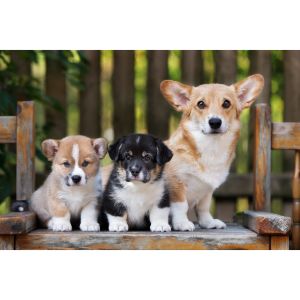
If you want to know what keeps animals from mating with family, the answer is nothing. Studies have found that animals mate with their relatives about 73% of the time. Stockholm University studied 88 species for over 40 years to track their mating habits. All studies happened in captivity to control the experiment better than in the wild.
The results found that animals will mate with a relative if that’s the only option. Rather than not mate, their instinct is to try mating to carry on their lineage. It’s in their biology, so they’re not picky about who’s the mate. This issue is especially prevalent in captivity, where the animals are always around each other.
In the wild, animals are more likely to leave their pack. They have a chance to explore a new area of land and meet different animals. Once they leave the herd, they’ll rarely reencounter their relatives. Therefore, there was never a need for them to develop a process to avoid inbreeding. It simply wasn’t likely to happen.
Humans can impact animal reproduction even in the wild. Due to population growth, civilization encroaches on land once left entirely to the animals. When humans start building in those areas, the animals must move. It also changes their migration patterns and guarantees that family members in one herd have prolonged contact with each other.
Zoologists encourage breeding in captivity to sustain at-risk populations. However, the animals born in captivity are often the result of inbreeding. They’re likely to have health complications, including weakened immune systems, which means they’ll have trouble surviving in the wild. Therefore, breeding in captivity isn’t always the best answer.
Many breeding programs share animals, so those in captivity still have a chance to pick their partner. This method of breeding helps encourage genetic diversity. It’s more effective at continuing endangered populations without introducing new health concerns into the mix.
Inbreeding in Animals
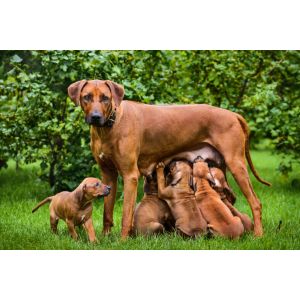
Most researchers agree that inbreeding refers to animals mating with close relatives, like parents or siblings. However, cousins are close relations, but there are arguments as to if they fall under the definition of inbreeding.
Cousins have different parents, but at least two of those parents are siblings, so there is still some shared genetics. Scientists only define animals as unrelated if they don’t have a common ancestor in the previous five generations.
In cases with unknown variables, there’s no guarantee that the resulting offspring will be healthy. Any commonality in the family line increases the risk of homozygosity or the likelihood of similar genes.
Farmers don’t often worry about the genetic background of animals they’re breeding for meat. There’s no proof that inbreeding impacts meat quality. Therefore, animals like cows, pigs, and chickens that are only raised for slaughter aren’t held to high standards. There’s no need to keep them healthy and give them a good quality of life.
Some farmers have found that inbreeding pigs lead to a smaller litter. Though inbreeding doesn’t impact the meat quality, it detracts from their overall income because they’ll have fewer pigs to sell. As inbreeding impacts reproductive ability, the problem of litter size can get exponentially worse over time.
What Happens When Animals Inbreed
There is a lot of research on inbreeding in dogs because people want to adopt purebreds. The only way to ensure you have a purebred is to know the background of the mother and father. Breeding dog siblings ensures you’ll have a purebred dog to sell for more money than a mutt.
Breeders use siblings to ensure the next litter has a certain color coat or type of ear. When breeders mate siblings, it can often turn out better than when it happens naturally. If puppies reach six months without getting spayed or neutered, they’re likely to mate with siblings and create inbred puppies.
But inbreeding reduces genetic diversity, which can hinder the animal’s growth. Dog siblings that breed with each other don’t give the strongest genes a chance to come out in their offspring. Illnesses that exist in sibling dogs are easily passed to the next litter and can become more serious. Corgis are just one breed that has health issues due to inbreeding over the years.
The solution to extending a line of purebred dogs is to not mate siblings. Instead, you can mate a purebred Great Dane with another purebred Great Dane from a separate family. You’ll still get the traits of a Great Dane with no shared DNA. Both dogs have different parents, so their litter will have diverse genes, strong immune systems, and are less prone to health problems.
Overall, inbreeding in animals produces the same detrimental effects as it does in humans. Over time, the gene pool becomes less diverse, so it’s more likely that diseases and weaknesses will flourish. There’s a decrease in the health and performance of the animals.
Frequently Asked Questions (FAQ)
What Happens When Siblings Mate?
Inbreeding occurs when siblings mate. Generally speaking, it isn’t obviously dangerous but can have long-term impacts on the health of the entire family if they keep inbreeding.
Does Inbreeding Affect Animals?
Yes, inbreeding does affect animals. It leads to worse reproductive efficiency, and poor growth rates and increases the likelihood for those animals to develop some sort of abnormalities and carry diseases.
Do Wild Animals Know Not To Mate With Siblings?
Yes, generally, animals do not mate with their siblings unless absolutely necessary. At some point, their need to reproduce and produce offspring is a far more important task than ensuring that they mate outside the family.
Conclusion For Can Animals Breed With Siblings

So, can animals breed with siblings? The answer is that no biological component prevents animals from breeding with siblings. They can even mate with their offspring, though these partnerships restrict genetic diversity. Over time, animals resulting from inbreeding will suffer health problems and live a lower quality of life.
For more guides similar to this article about Animals Breeding with their siblings, you can check out:
For more information about Animal Breeding with relatives, check out the video “Is inbreeding dogs safe?” down below:
If you’re like most of us, you’ve looked at your adorable dog and thought it would be great to have more of these. There is more to dog breeding than what naturally occurs when you get a mommy dog and a daddy dog together. This also begs the question, what happens if you breed a dog without breeding rights?
Other articles you would like: Why Can’t a Human Breed With Other Animals? and The Best Animal Breeding Associations
What Are Animal Breeding Rights for Dogs?
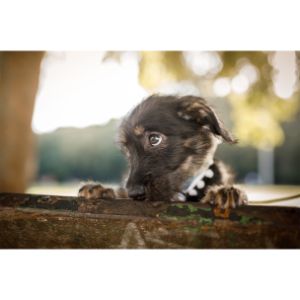
Breeding rights are a vital tool in dog breeding. Breeders use, bestow, and limit these rights to protect the development of the bloodline when selling puppies to third parties.
A litter of puppies born to a breeder without breeding rights will not be allowed to register with the American Kennel Club (AKC) and some alternative clubs. The AKC allows for two types of registration.
Full registration gives the puppy’s new owner the right to breed that dog and register the subsequent puppies. This type of registration costs more than limited registration.
Limited registration means that you can get AKC papers for your puppy, but you cannot breed the purchased puppy.
Why Do Breeders Limit Breeding Rights to Third Parties?

You may wonder why you need animal breeding rights for dogs. Dog breeding is an art and science meant to yield the best specimens in a particular breed.
Some dog breeders work over generations of dogs to select the best candidates to build a bloodline that results in the strongest, healthiest, most beautiful members of their breed. As those puppies grow and breed to the next generation, they represent the original breeder and their hard work.
Most breeders consider it an ethical duty to stop certain genetic defects and congenital diseases from carrying forward into future generations of dogs. Selective breeding benefits the animals and future owners. Responsible breeders assure that only the very best of the breed carry their genes forward.
Limiting breeding rights for certain puppies helps strengthen the breed and the bloodline as a whole. Breeders also understand that limiting breeding rights means that they must significantly reduce the price of those puppies. The new owner will not be able to reap any financial benefit from breeding that dog in the future.
On the flip side, a puppy who is the epitome of excellent breeding choices is worth the top dollar.
Full Breeding Rights

When your puppy comes with full breeding rights you can be confident that it is free from congenital defects. You can enter that dog into shows or competitions and register any puppies (granted that the other parent also carries full breeding rights).
If you choose to breed a dog who carries full breeding rights, you enter into the work of building a durable and healthy bloodline. It behooves the new breeder to maintain that line by selecting a healthy mate, screening the puppies for defects, and possibly limiting registration on some members of future litters.
Paperwork

If you are reading this article, you are probably wondering, can I breed my dog without breeding rights? First, let’s look at what paperwork may be involved when you buy a purebred dog from an experienced breeder.
- Certificate of Ownership
- Health Certification
- Health Records
- Pedigree
- Breeder Contract
A certificate of ownership proves the breeder is the legal owner. You then register the dog in your name.
Health certification involves genetic testing, phenotypic evaluations, and other tests for congenital problems. Typically, breeders let you know up front what tests they provide. The cost of testing is one reason purebred dogs sell for more than puppies from a backyard breeder.
Two organizations that supervise the health certification process are The Canine Health Information Center (CHIC) and the Orthopedic Foundation for Animals (OFA).
The health record shows the dog’s vet visits, medical procedures (if any), and vaccinations.
The Pedigree authenticates your dog as a pure breed by showing its lineage through three generations. It’s your dog’s family tree.
A breeder contract may include any number of clauses that bind you to certain obligations. Many breeders include a spay or neuter clause for pet quality dogs. Another possibility is a return-to-breeder clause. If for any reason, you must rehome your dog, the breeder wants notification about the change in ownership.
Be sure you understand everything in a breeder contract before signing.
Pet vs. Breeding Rights

Breeders distinguish between pet-quality puppies and puppies with show quality potential.
Pet Quality Puppies
When a breeder considers a puppy will not become a showing or breeding candidate, they will sell it with limited registration. That puppy can participate in AKC events except for dog shows and any puppies of theirs cannot be registered.
While there is no category of pet breeding rights, some contracts may require you to spay or neuter a dog sold with limited registration. The AKC’s position on spaying and neutering is that “these important decisions should be made on an individual basis.”
Various opinions exist among vets and breeders about when is the best time to spay or neuter dogs. As more research accumulates on the matter, waiting for these procedures until a dog reaches maturity seems to be the best course.
Once you own the dog, you would be responsible to fulfill your contractual obligation to spay or neuter. Breeders are not looking for a legal “gotcha” when they include this clause in a contract. Most of them feel passionate about ethical breeding practices and the health and well-being of the puppies they bring into the world.
Potential Show Quality Puppies
A breeder may determine that a puppy has the potential to grow into an excellent specimen. In this case, they will sell the puppy with full breeding rights. However, a contract may have several more stipulations including seeing the puppy at a certain age, showing the puppy themselves, or hiring a professional handler for shows.
Breeding may carry more contractual obligations for puppy health screenings, responsibilities for whelping and placing future puppies, when breeding happens, financial arrangements, etc.
Co-Ownership

One option for new breeders who need a mentor while getting into breeding is co-ownership.
How to Co-Own a Breeding Dog
The best practice is to sign a highly-detailed contract for every aspect of raising and breeding a co-owned dog. How costs and responsibilities are split between the owners depends on the individual arrangements made by the parties involved.
Like any contract, be sure you understand every clause clearly before signing. If you are uncomfortable with one or more aspects demanded by the breeder, consider finding another partner.
Many breeders desire co-ownership over their best show dogs. These animals represent them as breeders, making it a wise investment to stay involved in the dog’s show career.
Breeding Without Breeding Rights

In some cases, you can purchase a puppy under limited registration but won’t be contractually obligated to spay or neuter that dog. You would be breeding without breeding rights, sometimes called breeding without papers.
Breeding a dog who has limited registration carries some consequences. While your dog technically “has papers” because it is registered with the AKC, the puppies are not eligible for registration or to participate in any AKC shows.
The AKC began the limited registration option because it found that breeders were withholding registration papers when a puppy went to a non-breeding home. Sometimes the new owners bred the dogs anyway. When they tried to register the puppies, they found that their dog remained under the original breeder’s name.
This may lead you to wonder what happens if I breed my dog without breeding rights? You cannot register the puppies with the AKC. However, there are other registries where you can register them.
As long as your breeder contract does not have a spay/neuter clause, you are free to breed your dog. As limited registration has risen among AKC breeders, the practice of using alternative clubs has risen in popularity.
If you did sign a contract with a spay/neuter clause, the breeder could sue to reclaim the animal. It depends on the terms of the contract, but it is enforceable in court.
Frequently Asked Questions
Why Do Breeders Charge For Breeding Rights?
Breeders charge for breeding rights because those pups are of higher quality. Moreover, these pups are generally screened, vetted, and taken out of the litter for their exemplary qualities which nets them a higher price.
What Happens If You Break A Breeder Contract?
A breeder can exercise the legal right to reclaim their dog and you might not be able to join the kennel club of your choice. Depending on the nature of the contract, legal action may be taken against you as well.
What Does Limited Breeding Rights Mean?
Limited Breeding Rights means that your dog itself is registered and allowed to participate in shows. However, any of its offspring cannot be registered under any circumstance.
Conclusion For What Happens if You Breed a Dog Without Breeding Rights?

So, can you breed without breeding rights? Yes. You should carefully consider whether to breed your dog when you don’t have breeding rights from the original breeder.
Limiting breeding is a tool that protects healthy bloodlines to produce puppies who do not carry genetic abnormalities or diseases.
You may have a contractual obligation to spay or neuter your dog. Not fulfilling that obligation is risky. If you are not comfortable signing a contract with a spay/neuter clause, consider finding a puppy from a breeder willing to provide full registration or at least not require fixing your dog.
What happens if you breed a dog without breeding rights? You’re not likely to face legal action except in certain circumstances. The puppies will not be eligible for registration with the AKC and some other clubs. There are alternative registries for limited dogs.
You will also like:
- Maltipoo Breeders in Illinois
- Ferret Breeders in the United States
- Cavalier King Charles Breeders in California
For more information about Dog Breeding, check out the video below:
We might think that ‘selective breeding’ refers to the process that gave us Labradoodles, pugs, and other designer dog breeds. However, selective breeding is a practice that goes back thousands of years.
Ever since dogs first started following humans around, scavenging our food, and sleeping near our fires, we have been selecting our favorites and breeding them.
Nowadays, dogs are bred for looks as much as anything. Historically, we bred them for their intelligence or certain behavioral traits. Traits that make them good snugglers, better bird-dogs, or scarier guard dogs make dogs desirable to us.
Unfortunately, the practice of selective breeding comes with some drawbacks. Congenital diseases and undesirable conditions such as brachycephalic syndrome have developed because of inbreeding or purposefully breeding for a genetic deformity, regardless of the dog’s health.
In this article, we will explore the history of selective breeding, how selective breeding affects dog populations, and answer the question, “why would dog breeders select specific dogs to mate?”
Other articles you would like: Best Animal Breeding Associations and Best Dog Breeds For Hog Hunting
Why Would Dog Breeders Select Specific Dogs to Mate?

It can be hard to understand why anyone would want to mate two dogs from the same immediate family together. In human mating, this is a huge cultural taboo. Too many dog breeders, it is becoming taboo as well.
Inbreeding is to blame for the development of many of the congenital conditions that plague domestic dogs today. These include hip dysplasia in German shepherds, Addison’s disease in Old English sheepdogs, and ataxia in Jack Russel terriers.
The primary reason these conditions develop is that breeders often choose dogs with similar traits to increase the likelihood that their offspring will inherit them. For example, if two dogs from the same litter display an aptitude for retrieving, a breeder might breed those dogs to increase the likelihood that the puppies will be good retrievers.
This practice is becoming less common as breeders are beginning to understand that hidden genes and alleles in genetically similar dogs can increase the likelihood that the puppies will inherit congenital conditions.
Congenital conditions can develop in mixed-breed dogs. It is not only purebred dogs that can suffer from these diseases. However, introducing new genes into a gene pool decreases the chance that both parents will be a carrier of a particular genetic trait. Therefore, mixed-breed dogs are less likely to have congenital conditions.
It is also worth mentioning that inbreeding and line-breeding do occur naturally. However, in the wild, when these phenomena lead to genetic problems that make the offspring unfit or unable to survive, natural selection quickly eliminates the offspring.
This process of natural selection means that, in the wild, bloodlines that contain congenital conditions are unlikely to develop because unfit members of the species will simply die. Under human care, however, animals that might die in the wild can survive, even thrive, and sometimes breed.
How Did Early Humans Breed Dogs?
The earliest selection of dogs occurred naturally. Dogs were initially attracted to humans because we had warm fires and because we discarded food scraps that they could scavenge. Dogs who chose to remain close to humans benefited from these things and could breed more prolifically. Dogs who did not stay close to us often perished.
Soon, humans began to realize the benefits of our relationship with dogs. Namely, dogs bark when danger comes near, dispose of our food waste for us and assist with hunting. Dogs who were good at these tasks were rewarded with food and shelter, enabling them to breed more successfully.
Dog Breeding as a Hobby
By the time “dog breeding” became a recognized activity in the 19th century, we had already been unconsciously breeding dogs in this way for thousands of years. In the 19th century, people began to keep records of bloodlines and classify dogs into breed groups. Noblemen and women bred dogs for sport, and breeding became a hobby.
How Does Dog Breeding Work Nowadays?
Today, more than 400 dog breeds are recognized worldwide, and we continue to breed dogs for certain desirable traits. Breeding today is informed by genetic research that allows us to carefully select these traits.
Unfortunately, selective breeding has led to many problems for pure-bred dogs in the last hundred years.
Humans have unknowingly bred dogs with genetic markers for disease. We have also knowingly bred dogs from the same bloodlines, and purposefully enhanced certain desirable deformities. This type of selective breeding has led to a proliferation of diseases and genetic problems in many pure breeds.
For example, pugs before selective breeding were less likely to suffer from breathing problems and had much less ‘wrinkly’ faces. It is important to understand, however, that pugs have been pugs since about 400 B.C. Their squashed faces and wrinkles are not a new development.
What Kinds of Traits Are Animal Breeders Looking For?

Breeders look for traits that they believe will make a dog desirable. These might be physical or behavioral traits. Breeders who intend to sell their dogs to families as pets will seek out different traits than breeders who intend to use their dogs to herd sheep, hunt birds, or race.
Pets
People who breed family pets look for dogs that are easy to socialize, medium-sized, confident, not prone to aggression or anxiety, and of average intelligence. They also seek out dogs with strong desires to be near humans.
Some dogs, through thousands of years of selective breeding, are more inclined to be with their humans. These include Labradors, Golden retrievers, Pomeranians, German shepherds, and most household pets.
Working Dogs
Other dogs do not make such good companions for the average family. They are bred to do work, so they are genetically predisposed to be more energetic, more intelligent, and require more stimulation to be happy. Some may even require a specific ‘job.’
These dogs include Belgian Malinois, Huskies, Border Collies, Australian Shepherds, Pointers and other bird dogs, and many hounds. Often, these dogs are independent and may not bond with their human in the same way that a family pet may bond. Often, they are highly intelligent or very energetic and do not do well in the average household.
How Has Research in Genetics Changed Pet Breeding?

Until quite recently, breeders bred dogs by a method called the ‘candidate gene’ approach. This involved guessing which genes were responsible for particular traits or diseases, and selecting dogs that were thought to carry those genes.
Breeders and scientists developed hypotheses about what happens when a gene is present and tested those hypotheses via breeding.
This process was usually frustrating and resulted in more misses than hits. It was also expensive and time-consuming. Hypotheses could only be tested by physically breeding dogs and then studying the offspring to determine the results.
The Dog Genome Project
The dog genome project, launched in the early 1990s, was an attempt by scientists to discover and isolate the genes that lead to many of the problems faced by purebred dogs. The project involved mapping the genomes of hundreds of thousands of dogs to build a genomic map to allow scientists to navigate the entire dog genome.
In 2003, scientists mapped a partial sequence of the DNA of a standard poodle. This sequence made up about 80 percent of the complete dog genome. Shortly after, geneticists fully sequenced the boxer genome, filling in the gaps and providing the reference sequence for the dog’s complete DNA.
This research has led to the creation of resources that allow us to manipulate dog DNA. The availability of a fully mapped dog genome has also enabled geneticists to understand which genes are responsible for which traits.
It has also allowed scientists to draw genetic distinctions between breeds. Before this work, we drew breed distinctions based purely on visual and assumed behavioral characteristics.
Pet Breeding Genetics
This work is beginning to proliferate into pet breeding as commercial and private dog breeders are beginning to understand the ramifications of genetic markers in their dogs. Responsible breeders may now order genetic tests for their dogs before breeding them to ensure that the parents do not pass down certain diseases to their offspring.
How Can Random Breeding Affect Overall Animal Health?

Random breeding, or random mating, is mating with no regard for genetic makeup. It is also called panmixia, and it is a near impossibility. This is true for any species, not just dogs.
Random mating assumes that all partners within a species are potential partners, meaning there are no behavioral, cultural, or genetic restrictions on breeding.
For a truly panmictic population to evolve, there would need to be no age limit on breeding, and no cultural boundaries surrounding inbreeding. Additionally, all members of the population would need equal access to all other members (i.e. have no geographical obstacles.)
Random breeding of dogs would mean breeding, for example, a chihuahua puppy with an adult St. Bernard. This can and does happen, however, it is rare, and it is not what most people mean when they say ‘random breeding.’
Assortative Breeding
What most people mean when they say ‘random breeding’ is ‘assortative breeding.’ Assortative breeding involves breeding similar phenotypes. It is what humans do. Assortative breeding involves selecting dogs with complementary genetic structures rather than simply breeding dogs with ‘the best genes.
Assortative breeding can be beneficial to the health of purebred dogs. Often, dogs who have ‘the best’ genes for a particular trait carry hidden genes that can arise in the offspring and cause problems. Historically, this problem was solved by ‘outcrossing’ (introducing the genes of an entirely different breed).
Assortative breeding means that instead of selecting two dogs with dominant alleles for a gene, you choose one dog with a dominant allele and one with a recessive allele. This process will decrease the risk that the dogs share a hidden gene for an undesirable trait.
Who Was the First Person to Breed a Dog?

It is impossible to know who the first person was to breed dogs. Some of the earliest evidence for selective breeding has been found in Siberia. The partnership between humans and dogs goes back almost 15,000 years. Throughout this period, humans have, consciously or unconsciously, selected dogs to breed.
Frequently Asked Questions
Do Dog Breeders Force Dogs To Mate?
What Type Of Selection Is Used In Breeding Dogs?
Are Dogs Selective Breeders?
Conclusion For Why Would Dog Breeders Select Specific Dogs to Mate?
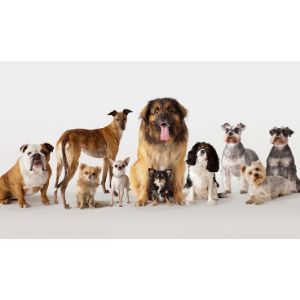
Selective breeding has been happening for tens of thousands of years and has given us the enormous variety of dog breeds we see today. Recently, genetic research has given scientists greater insight into how selective breeding affects dog populations.
When we breed two dogs of a similar genetic structure, the likelihood that the offspring will inherit desirable traits increases. However, the likelihood that undesirable traits (such as congenital diseases) are passed on also increases.
Purebred dogs from bloodlines that have been inbred or bred through line breeding are more likely to carry genes that will pass on congenital conditions to their offspring. The best way to prevent this is to practice assortative breeding or outcrossing to introduce new and complementary genes into the bloodline.
You will also like:
- How To Make Dogs Breed Successfully
- Will a Dog Breed While Bleeding?
- How Old Do Male Dogs Have To Be To Breed?
For more information about Dog Breeding, check out the video below:
Coyotes and dogs are similar animals, and they are both in the Canidae animal family. Dogs breeding with each other produces more dogs, and the same happens when coyotes breed. But, can coyotes breed with dogs, and if so, what happens?
Yes, Coyotes can breed with dogs which creates an animal called a coydog. However, it is not common for coyotes and dogs to breed together because of their breeding seasons, the bonds between the parents, and their low fertility rates. It happens, but coydogs are rarely kept as pets since they are wild.
This article explains how coyotes and dogs can breed, why coydogs are not more common, and whether or not they make a good pet.
Other articles you would like: Why Can’t a Human Breed With Other Animals? and How Often Can You Breed a Dog?
Coyote and Dog Breeding

Coyotes and dogs can breed, and their offspring have a good chance of surviving and being born healthy, thanks to the similarities between the two animals.
And, the result is an animal called a coydog, a combination of the two animal names. Scientists sometimes refer to coydogs as eastern coyotes.
Some coydogs are hard to recognize because they look so similar to one of their parent animals. Just because an animal looks like a coyote does not mean they do not have any dog ancestry and vice versa.
Coydogs have some common characteristics that make them easier to identify compared to dogs or coyotes.
Many coydogs have gray fur, as do most coyotes, but they can also be other colors like blond, black, and red, which is less common in coyotes. Their unique coloring comes from the dog. Coydogs also weigh more than coyotes on average and have a more deer-based diet, which is where the excess weight comes from.
Are Coydogs Common?

Even though coyotes and dogs can breed, they are not very common. You will not find any domesticated coydogs, but some are in the wild, and some have been raised in captivity for scientists to study.
Scientists can estimate how many coydogs are living in the wild, but it is a rough estimate because they need to perform DNA testing to determine which animals are a mix of dog and coyote; looking at them is not enough to tell.
Coydogs often get mixed up with coywolves, which are a similar hybrid but the coyote breeds with a wolf instead of a dog. The two animals look similar, but most wolves in North America have some coyote DNA in them. But, there are significantly fewer coydogs on the continent.
However, these animals used to be much more common. Starting before the colonization of the Americas by Europeans and lasting into the 20th century, people in Mexico and Canada would purposely breed coyotes and dogs.
In Mexico, they wanted guard dogs, but domestic dogs were not as big and intense, so they wanted some coyotes in them. And, in Canada, they bred coydogs as sled dogs.
Next, we will get into the reasons coydogs are not more common.
Reasons Coydogs are Not More Common

So, coydogs exist but are not as common as they could be. Why is this? There are a few reasons why coydogs are not more common:
- Different Breeding Seasons
- Single Parent Litters
This section details these reasons.
Different Breeding Seasons
First, dogs can breed anytime, but coyotes are seasonal breeders. So, a dog and a coyote would have to meet and breed at a specific time of year for the coyote to be ready to breed together.
Furthermore, coydogs inherit the seasonal breeding trait. Coydogs can mate with dogs or coyotes to produce more of these species. But, their breeding season does not align with the coyotes’ breeding season. So, coyotes and coydogs rarely breed with each other, and dogs and coydogs breeding is just as rare as dogs and coyotes breeding because of the seasonal breeding.
When coydogs do breed, they are most likely to breed within the coydog family since their mating cycles line up.
Since coydogs are rare, to begin with, it is difficult for coydogs to reproduce together enough to create a significant population of them. And coydogs are a hybrid species which oftentimes means they are not as good at breeding as pure animals. Their fertility is often lower, which leads to an even smaller chance of the coydog population becoming more prevalent.
So for coydogs to be more common as a species, dogs, and coyotes would need to breed much more than they already do. But, for all the reasons we explain in this section, they do not breed all that often, even though it is possible.
Single Parent Litters
Another reason why coydogs are not common is that the coydog dad does not stick around to help the mom of the other species raise the litter. The mom is left alone to care for her coydog pups, and they have a lower chance of survival.
Coyotes and dogs will only stay together long enough to get pregnant, then they go their separate ways, but when dogs or coyotes breed with their own species, the mom and dad bond and both are there to keep their pups safe after they are born.
Are Coydogs Good Pets?
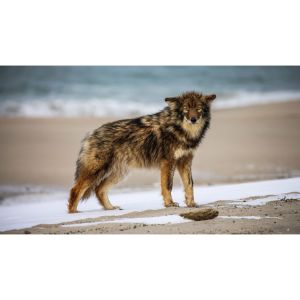
You can keep coydogs as a pet, but it is quite uncommon, and if you want a coydog pet, you need to be an experienced dog owner. As detailed in this section, there are many things to consider if you want to domesticate a coydog.
Temperament
Coydogs do not make good domestic pets like other dogs since they are partially wild animals. With the coyote in them, they are quite temperamental and require a lot of attention and patience. They tend to get very attached and protective of their owner, resulting in violent behavior against others.
The coydog needs to be trained from a very young age if you want to have an easier time keeping them as a domestic animal.
Exercise
One of the best ways to make sure they stay happy and safe is to make sure they get a lot of exercise. Coydogs need a lot of space to run around and a lot of time to do it. Just like dogs, they want you to play with them, and the exercise needs to be daily, just like a coyote would have in the wild.
Health Concerns
Coydogs also might face some health issues, and they have a wide life expectancy ranging from 5 to 15 years. Some common health issues in coydogs include arthritis, hip dysplasia, and elbow dysplasia. Their life expectancy depends on whether or not these health conditions affect them and how well taken care of they are, including their diet, exercise, and affection.
You also need to find a vet who is familiar with coydogs and their health when you take one for checkups and shots.
Coydog vs. Dog Characteristics
Furthermore, coydogs have some characteristics that dogs do not, and owning them may be difficult. First, coydogs need a lot of space to themselves, like a den they would have in the wilderness. It needs to be their own space, and they should not share it with other pets.
Size
And, since coydogs are bigger than most dogs, they need their den to be spacious. Their size also means they require more space in general and a lot more food. So, owning a coydog might be more expensive than owning other types of dogs.
Energy Levels
Coydogs are also very social, and when they want attention, you need to give it to them. If coydogs want to lay down with you or play a game, you better be willing to do so. Otherwise, they will be offended, and their hot temper may show. However, they tend not to like to be pets as much as dogs, but they do like to cuddle.
Furthermore, when coydogs do want to play, they might want to do more than just play fetch. They are smart animals, so you may want to find toys and games that will challenge them. Unfortunately, their intelligence also means they are pretty quick to learn how to open doors and get into things in your home that they are not supposed to.
Noise
Coydogs are noisy like coyotes. Sometimes they bark similarly to how dogs do, but they make a lot more noise and different noises too.
They can howl, and at times it may be high-pitched, which can be very annoying, and even startling the first time you hear it. A coydog will likely break all noise regulations if you have close neighbors or roommates, especially in an apartment building.
Frequently Asked Questions
Can Coyote Breed With A Dog?
Yes, a coyote can breed with a dog. They do produce hybrid litters and they are referred to as coydogs. However, they’re quite uncommon as coyotes and dogs have erratic breeding patterns.
What Happens When A Coyote Mates With A Dog?
When a coyote mates with a dog, they produce a hybrid called a coydog. This isn’t very common since coyotes have a specific breeding season while dogs do not. Plus, dogs typically do not exist in the wild.
Can A Wolf Mate With A Dog?
Yes, a wolf and a dog can mate with each other. The offspring is known as Wolfdog and generally is known for its wild behavior as compared to domesticated dogs.
Conclusion For Can Coyotes Breed With Dogs?

So, can coyotes breed with dogs? Even though it is rare, it is possible, and the new animal is called a coydog. Coydogs are not a common species since they have low fertility, and coyotes do not breed with dogs enough to make a significant population.
Occasionally coydogs are kept as pets, but this is not ideal for most people since they can have a temper and need a lot of attention to play and exercise.
You will also like:
- How Old Do Male Dogs Have To Be To Breed?
- How To Make Dogs Breed Successfully
- Will a Dog Breed While Bleeding?
For more information about Coyote Breeding, check out the video below:
Both cats and dogs are beloved pets in American homes and many other homes across the globe. They are seen as companions and are welcome in homes as part of the family. However, this begs the question, can cats and dogs breed?
No, cats and dogs cannot breed because of the genetic variance between them. They are of different species and have different chromosomes, 38 and 78, respectively.
Other articles you would like: How Old Do Male Dogs Have To Be To Breed? and How To Make Dogs Breed Successfully
Can a Dog and a Cat Have a Baby?

No, a cat and a dog cannot have a baby. This is because they are two completely different species. While they do bond with each other quite strongly if they live in the same house, they, for better or for worse cannot produce offspring.
Why Do My Dog and Cat Act Like They Mate?
Concerned pet owners may be alarmed when their dogs appear to be engaging in mating behaviors with their cats. This behavior is understandably alarming! However, it is normal behavior. They are not engaging in mating or breeding behavior even when it may look like they are.
Dogs mount things often. It is not unusual for it to be like breeding behavior. Contrary to popular belief, dogs can mount almost anything! Commonly mounted objects include furniture, human legs, or anything that stays still long enough for them to do so.
This behavior can come from neutered dogs as well as female dogs. Therefore, you can infer that it is not typically inherently sexual; it is often a sign of dominance. This dominance factor is especially true when it involves other non-dog animals such as your household cats.
In addition to dominance, mounting can also be a playful act. Mounting as an act of play is especially prevalent in puppies playing with other dogs or cats. Your dog can also mount when they are stressed or anxious because of an external circumstance.
Dogs mounting cats is not something to be inherently worried about unless it seems violent or harms the cat involved. If you see your pets hurting one another, you should intervene. However, it is typically harmless and playful banter.
Cat Breeding vs. Dog Breeding

We will now get into the technicalities of why cats and dogs cannot breed. Their breeding processes are very different and wildly incompatible with one another. Here’s a quick look at some of the differences:
Cat Breeding
Cats, especially females, are notorious for being obnoxious in their mating rituals. Female cats go into heat at a young age and will announce it to the entire household by meowing loudly. They may sit by windows and vocally call for a male to mate.
This sensitive time is not when you should trust your cats with screened windows, as cats have torn through window screens to find a mating partner, talk about rabbit-like behavior!
Ovulation occurs in cats after mating. If a female cat gets pregnant, it can carry kittens from different fathers. This phenomenon event is unusual for humans and many other species of animals.
Dog Breeding
Dog breeding is a process that many dog owners find hard to do in conditions that are optimal for all involved. Dogs may be up to two years old before they go into heat. They then ovulate based on their cycle and not on mating.
The Takeaway
Not only would cats and dogs mating be odd and a disaster altogether, they logistically cannot. Their reproductive systems are different and not compatible in any sense.
Is There a Cat Breed That Acts Like Dogs?
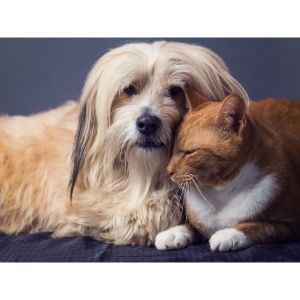
A common reason people may not gravitate toward cats the same way as they do toward dogs is that cats are typically more reserved and live by their own rules. Dogs are commonly affectionate and social creatures.
However, there are cat breeds that have personalities and demeanors that resemble more like a dog than a stereotypical cat! Of course, these cats are still cats, but they do have some dog-like qualities.
Maine Coon Cat

Maine Coon Cats are one of the largest domestic cat breeds that exist! They often take on the nickname gentle giants because their disposition is typically cuddly, playful, and friendly. These traits make them ideal for families with children and those that need a calmer cat. Their large size is also comforting and their fur is incredibly soft and fluffy.
Birman

Birmans are silky longhaired cats that are known as a loving breed. They are best companions because they love being with their owners. They are not very active. They typically prefer calm environments and may not be a good match in a home with children because of this. A slow-paced life will complement their calm demeanor the best.
Is There a Dog Breed That Acts Like Cats?

Cat people often say they do not gravitate toward dogs because they are dirty, rowdy, or loud. While these can be true for certain dogs, some breeds are more likely to differ in these tendencies and act more like cats than typical dogs. These similarities to cats are only in demeanor. Dogs will always be dogs!
Basenji

Basenjis are perfect for pet owners that prefer a quieter dog. They are often a silent breed; some are even barkless! They are also like cats in their stubborn tendencies and independence. Beware if this is not a trait you can love!
Whippet

Whippets resemble cats in their love for laying around the house with their owner. They also are notorious for getting along with cats! If you are looking for a dog so cuddly that they behave like a cat, a Whippet may be just the dog for you.
Frequently Asked Question
Can A Dog And Cat Successfully Mate?
No, a cat and a dog cannot successfully mate. This is because they belong to two different species and have a lot of genetic disparity between them for mating to be successful.
Why Does My Dog Try To Mate With Cats?
Dogs engage in mounting a display of dominance or excitement. They are not actually trying to mate with a cat.
Is It Possible For A Cat To Breed A Dog?
No, it is not possible for a cat to breed a dog. This is because they have a different number of chromosomes which leads to them having a lot of genetic variance between them for breeding to occur.
Conclusion For Can Cats and Dogs Breed

Since cats and dogs have different mating behaviors, are biologically different, are of different species, and have a variance in chromosomes, cats and dogs cannot breed with each other.
Cats and dogs differ a lot in personality, temperament, and typical behavior. The common dichotomy between “cat people” and “dog people” is notorious but it is possible and common to love both animals!
For more guides similar to this article about Cat and Dog Breeding, you can check out:
For more information about Cats and Dogs Breeding, check out this video down below:
Aussiedoodles are loyal, fun-loving dogs who inherit some of the best traits from both parent breeds. This dog breed comes from Australian Shepherds and Poodles, and they certainly act like both dog breeds. Aussiedoodles love affection and attention, and this dog breed thrives on playtime.
This need for activity can get expensive for some families who need new toys to replace destroyed or lost toys. Aussiedoodles can be a little pricey – because of their upfront cost from breeders.
So, how much do Aussiedoodles cost? Usually, Aussiedoodles cost between $2,500 and $5,000. The Aussiedoodle price range includes the cost of the toy, miniature, and standard Aussiedoodles.
However, this cost can vary depending on many factors. After adopting your Aussiedoodle, plenty of hidden or unexpected fees may pop up, leaving you nervous about the price.
Aussiedoodles are designer dogs, which may cost a hefty penny more than other dogs, even purebreds. Keep reading to learn how much Ausiedoodles cost.
Other articles you would like: The Best Animal Breeding Associations and How To Make Dogs Breed Successfully
What Determines The Price Of An Ausidoodle?

There are dozens of factors that can determine the price of an Aussiedoodle. Not only can the strength of genetics, breeding stock, and colors determine the cost of an Aussiedoodle, but the cost can change depending on a breeder’s reputation and the demand for the dog breed.
Aussiedoodles are designer dogs, meaning they are carefully bred and may need extra care and attention to detail during the breeding process. This care and extra effort may reflect heavily on the price.
Genetics
The genetic output of the litter of puppies is one of the main factors that make an Aussiedoodle puppy more or less expensive. For example, solid-colored Aussiedoodles are rare and typically indicate strong genetics. As a result, these puppies will be more expensive, likely costing around $5,000.
Alternatively, any runt of the litter or a puppy who seems too tiny may still get adopted but will likely cost a lot less.
Colors
The color of an Aussiedoodle will make them more valuable. Any Aussiedoodle with a rare color like apricot, chocolate brown, or red phantom coloring will cost a lot more than those without unique color patterns.
Meanwhile, Aussiedoodles without any unique color pattern may cost a lot less.
Breeder
The breeder and their reputation will make an Aussiedoodle cost more or less money. If a breeder is known to treat their animals poorly, or have unnecessary charges, their Aussiedoodles may be less expensive due to less demand.
However, when a breeder is respectable and highly desired as the source of a puppy, their Aussiedoodles will be more expensive.
Parents
The parents of a puppy are usually called the breeding stock. When the parents of a litter are in good health, have stunning colors, or are well-behaved, the cost of the puppies in that litter will go up. The parents of an Aussiedoodle are usually well-behaved dogs, meaning that Aussiedoodles are generally more expensive than other dog types.
Area
If there is a high number of Aussiedoodle breeders or owners in your area, you may be able to get an Aussiedoodle for a smaller price. However, if Aussiedoodles are rare in your area, they will likely come at a premium.
Aussiedoodle breeders often sell to people all over the country and may send their puppies out with a certified employee to deliver them. Consider this method if there are no breeders near you.
Number of Reservations
If the number of reservations to purchase puppies in an Aussiedoodle litter fill up, prices increase. Simple economics, the higher the demand, the greater the price. The more Aussiedoodle puppies available to reserve while still in the womb, the less expensive the puppy will be.
Type of Aussiedoodle
The type of Aussiedoodle you want to purchase will significantly impact the price. There are three types of Aussiedoodles, but they are all different sizes, require unique parents, and may have various needs.
Buying a Toy Aussiedoodle is far more expensive than buying a standard Aussiedoodle. This is because of their rarity compared to the other two size categories.
Types of Aussiedoodles
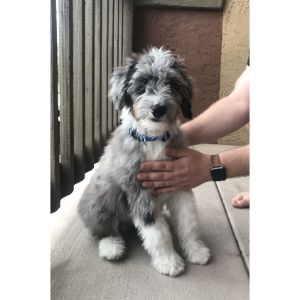
The type of Aussiedoodle you choose to adopt can impact the cost of your pet. There are three types of Aussiedoodles:
- Toy Aussiedoodle
- Miniature Aussiedoodle
- Standard Aussiedoodle
Some types of Aussiedoodles are more in demand than others, meaning that some will be much more expensive.
Of course, the same factors that contribute to the general cost of an Aussiedoodle may influence the cost of other types since the breeder may need different parents for the litter, new material, or more care for their puppies.
Toy Aussiedoodle

Aussiedoodle prices significantly increase when you are looking to adopt a Toy Aussiedoodle. This type of Aussiedoodle is much more expensive because the demand is higher. This Aussiedoodle type has been making waves for years, and because it is so tiny, it is perfect for many families who enjoy traveling and want to bring their dogs on adventures.
This dog type can cost more than $5,000.
Miniature Aussiedoodle

The Mini Aussiedoodle price is around $3,000 on average. However, this price is influenced by other factors, like overall health, breeder reputation, and coloration. Mini Aussiedoodles are designer dogs and are generally in high demand from people all over the country.
Aussiedoodle

Standard-sized Aussiedoodles can run as low as $1,500 but usually cost around $2,500. This dog is also notoriously a designer dog but is taller than a mini or toy Aussiedoodle. This dog is bulkier and has a higher desire to play than the other two types of Aussiedoodles.
Breeders Can Make The Price Vary

The price can change depending on where you get your Aussiedoodle puppy. Getting an Aussiedoodle from a reputable breeder may be challenging and nearly impossible for some people. For that reason, some people may seek out amateur or backyard breeders.
Breeding dogs is legal in the United States if there is no cruel treatment toward the dogs in question. Amateur breeders can be a decent alternative to accredited breeders.
Certified Breeders
Certified breeders who follow a strict code of conduct and have a model of transparency are the best types of breeders to purchase an Aussiedoodle.
Aussiedoodles can be hard to find, so choosing a reputable breeder in your area is vital. Many breeders will ship your dog with a certified companion to ensure their safety.
Amateur Breeders
Backyard or amateur breeders are ideal options to get an Aussiedoodle and may cost less than a certified breeder. These dog breeders may charge hundreds of dollars less than others but may require you to pick up your Aussiedoodle from their facility.
Puppy Mills
Puppy mills may sell puppies for a cheaper cost, but the conditions that puppy mills operate in are objectively terrible.
Puppy mills offer poor conditions for the puppies and mothers in their facilities. Unfortunately, many pet stores get their puppies from puppy mills, which are likely to forgo the health of an animal to make more money. Always ask where the litter of puppies came from before purchasing.
This means that several puppies may be placed in one small crate together, without room to play, eat, or rest comfortably. Puppy mills will sell puppies that are sick, haven’t been treated by a veterinarian, and have infectious diseases.
Choose a reputable breeder with an informative biography that shows who the people in charge are and how they care for their animals instead of a puppy mill. Although cheap, puppy mills treat their animals poorly.
How Much Is An Aussiedoodle Every Year?

Owning an Aussiedoodle can rack up a lot of charges between adoption and vet visits, making them one of the most expensive dog breeds. The total cost of owning an Aussiedoodle over a single year can be anywhere between $1,500 to $2,000 unless they need expensive medical care.
Everyday material, first-time needs, and daily food can cost a lot of money and empty your wallet if you’re not careful. Consider making a careful list of everything you will need to make your Aussiedoodle comfortable and happy.
Everyday Materials
Toys, feeding bowls, and leashes are everyday expenses that can have a large upfront cost when you first adopt your Aussiedoodle. You’ll likely spend several hundred dollars on a crate, bed, feeding bowls, toys, and harness.
There are plenty of needs your dog may have for the first several weeks or months in your home, and you may be spending a lot of money on these everyday items. Eventually, this cost will simmer down.
Vet Visits
Aussiedoodles generally have great health, but they will need plenty of vet visits to ensure they don’t develop any issues. Aussiedoodles may be prone to hip dysplasia and other issues as they grow older.
Training
You may want to train your Aussiedoodle yourself or have them trained by a professional. Either way, you’ll have to spend money on training treats or expensive professional services. Training services come in different forms, including room and board types and class types. These services can cost anywhere from hundreds to thousands of dollars.
Food
High-quality food without byproducts or fillers is the best product for your Aussiedoodle. This can cost $40 to $60 every month, generally. Avoid artificial colors, as well, since they can cause health problems such as cancer.
Grooming
Your Aussiedoodle will need to be groomed every few weeks. This dog breed has curly, thick hair that should be brushed out every few days, and will need to have its nails clipped and trimmed. Using a professional grooming service can be pricey, but save plenty of time and headache.
Grooming can cost anywhere from $25 to $50 every month.
Frequently Asked Questions
Are Aussiedoodles High Maintenance?
Yes, Aussiedoodles are considered a high-maintenance breed. This is because they’re from a Poodle and a Shepherd – both of which are extremely active breeds. Naturally, Aussiedoodles require a lot more mental stimulation than most other breeds because of this.
Do Aussiedoodles Like To Cuddle?
Yes, Aussiedoodles absolutely love to cuddle. They’re loving, caring dogs that will take their rightful place in their bed. So, prepare for a few minutes of cuddles and love.
Are Aussiedoodles Hard To Potty Train?
No, Aussiedoodles are not hard to potty train. They’re quite intelligent dogs. So, training them compared to most other canines shouldn’t be that difficult. Of course, your mileage may vary.
Conclusion For How Much Do Aussiedoodles Cost?

Aussiedoodles can be an expensive dog breed to adopt. Although they are loyal, charming, and fun-loving, this dog breed can cost a lot of money to adopt and plenty of money to maintain. Between adoption costs, vet bills, and toys to play with, Aussiedoodles can rack up a high bill that may have you struggling to pay.
Consider browsing your options for breeders in your area to see if you can get an Aussiedoodle from a kind facility at a cheaper price. You may also want to make a comprehensive list of everything your Aussiedoodle will need before adoption so that you can save up money for their arrival.
Aussiedoodles may have a high cost, but they offer a high reward. This dog breed loves people and will gladly spend its time making its owners happy. If you’re looking for an excitable dog who enjoys playtime and cuddles, an Aussiedoodle is right for you.
You will also like:
For more information about the Aussiedoodle Breed, check out the video below:
Can you breed different animals? Yes, you absolutely can! However, whether they produce offspring is dependent on how different their genetic code is from one another. If it is close enough, different animals can breed with each other.
Animal breeding dwells on the notion that the characteristics of the parents are often mirrored in the offspring. This concept stems from the fact physical characteristics are mostly heritable, and 50% of the DNA with the heritable capacity for an animal’s traits is transmitted from parent to offspring.
However, there is more than meets the eye with animal breeding. How do you select the animals to breed? Who decides what animals to breed? Can you breed different animals?
Continue reading to learn how to breed animals with different species.
Other articles you would like: How To Make Dogs Breed Successfully and How Often Can You Breed a Dog?
What Is the Difference Between A Species And A Breed
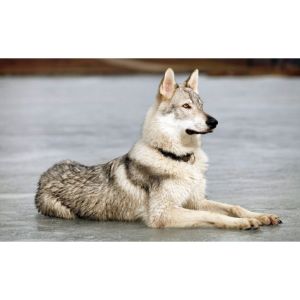
A breed is a group of animals from a particular species like domestic animals, while a species is a group of organisms that have the same characteristics and produce fertile offspring. Species are generally many things; they can be animals, microorganisms, or plants.
For example, a bulldog and a golden retriever are dog breeds. At the same time, blue whales, sunflowers, microscopic bacteria, and white pine are examples of species.
A breed is created selectively, while a species occurs naturally with no formulae. Several related animal breeds that can interbreed collectively form a species.
In essence, a breed consists of desired traits and attributes while a species is a fundamental unit used to classify organisms at large.
What Is Cross Breeding?
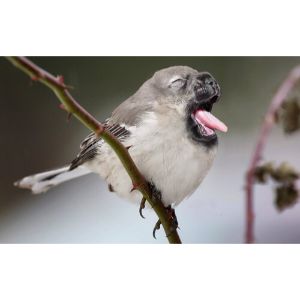
Cross breeding is mating two animals from two different breeds within the same species and producing offspring. Crossbreeding is the deliberate selection of animals for predetermined and heritable qualities based on their performance in a particular environment. The breeder chooses animals with the best mix of these features as breeding stock.
For example, a Bullmatian is a crossbreed dog whose parents are from the dog family but of different breeds. One parent is from the Bulldog breed, and the other is from the Dalmatian breed. On the other hand, a Cavapoo is a cross between a Cavalier King Charles Spaniel and a Poodle. In essence, different breeds of the same species can produce viable offspring with e ach other.
Cross breeding is done purposefully to improve different capabilities in an animal. Often, this mix of qualities will include traits relating to productivity such as egg count, growth, athletic performance, milk output, reproduction, and health.
However, it sometimes works against the main objective and brings out unhealthy animals that can barely survive, which is you should always resort to legit breeders and support them to promote ethical breeding practices.
How Close Do Two Animals Have To Be To Breed?

Typically, varying species do not often mate with one another. However, when this occurs, their progeny will be hybrids.
DNA molecules in every cell of an animal contain instructions. These instructions determine an animal’s appearance, behavior, and vocalizations. Once animals mate, their offspring inherit a combination of parental DNA and the parents’ characteristics.
If the parents belong to the same species, their DNA sequences are highly similar. But, DNA from distinct species or species groupings will exhibit greater variation. The DNA of hybrid offspring is more diverse than that of conventional offspring.
What then occurs once the DNA of two animal groups combines to form a hybrid? There are several potential consequences.
Occasionally, the animal breeding hybrid is weaker than its parents or does not survive. In other circumstances, the offspring could be stronger, borrow more behavioral traits from one parent species than another, or sometimes lie between that of either parent.
Why Can Dogs Cross Breed but Others Animals Can’t?

Humans determine animal breeding with different species through selective breeding or artificial selection.
Can you breed different animals? Yes, but you have to remember that natural selection plays a significant role in animals breeding with different animals.
The environment, not people, controls animals’ survival and reproductive viability through natural selection. Therefore, after determining what animals will serve as parents, they must reach reproductive age and breed effectively.
Natural selection also causes a shift in the direction of the average population. A species’ chances of surviving and reproducing increase if it adapts successfully to its surroundings.
In simpler terms, breeders have to rely on natural selection to have animals with their desired traits that they can later select and breed.
How To Breed Animals From Different Species?

Have you ever heard of tigons or ligers, which are animals that are a mix of tigers and lions? Wolfdog, a mix of dogs and wolves? Or a grolar bear, a mix of a grizzly and a polar bear?
Animal Breeding Hybrid
Hybridization is the process where animals from two distinct species crossbreed. While sometimes hybridization occurs in nature and is a potent evolutionary force, human influence has contributed significantly to animal crossbreeding.
Animal breeding hybrid is the progeny that results from crossbreeding. However, while some animals can successfully crossbreed, not all produce viable offspring. Therefore, when cross-breeding animals, you need to evaluate some key aspects.
The Desired Traits
You should consider all the genetic traits you desire in your offspring and ensure the parents you breed can pass on those traits. For instance, if leaping is the desired breeding feature for horses, evaluate the parents’ leaping abilities. Likewise, if you need strong and fast dogs, consider the parent’s speed and strength.
Parent’s Health
Another critical consideration is the animal’s family history, which indicates how healthy the parents are and whether they have any existing health concerns.
Consider the parents’ health by evaluating if they may have any hereditary diseases. Such parents are likely to pass on these diseases to their offspring. Also, evaluate whether the mother can handle the pregnancy and have a safe delivery.
Genetic Evaluation
Additionally, you should be aware that with crossbreeding, you would probably want the assistance of a specialist to avoid potential complications. Currently, DNA analysis is feasible and utilized in animals to track the transmission of different genetic features.
For the best counsel, reach out to an animal scientist, animal health technician, veterinarian, or any other qualified professional.
How Can CrossBreeding Harm an Animal?

Although humans determine animal breeding with different animals, it is clear that you can’t go against natural selection. You can’t defy nature because crossbreeding animals that are not genetically compatible will lead to weak offspring that cannot survive.
Also, the offspring might be excellent at a specific trait and weak at another. A good example is broiler chicken, whereby these chickens are very good at producing meat but aren’t resistant to diseases as the indigenous chicken.
The offspring will have more difficulty living and reproducing if humans do not step in. For instance, a negative correlation exists between increased milk output and the ability to reproduce or susceptibility to health issues in most bred cows.
How Far Should Humans Allow Animals Breeding With Different Animals?

As seen, in some cases, crossbreeding works against natural selection. People have become accustomed to how some hybrid animals demand assistance with their reproduction and survivability. However, how far should humans go?
Sometimes, it is crucial to understand why cross animal breeding is impossible.
For instance, cross breeding different dog breeds can lead to offspring with overly broad shoulders and/or heads. Having these features causes delivery complications. Without human assistance, including aid during birth or even a C-section, the offspring and mother would perish.
Another example is sheep, whereby, unlike indigenous breeds such as the Romanov, many sheep breeds cannot naturally shed their coat without human assistance.
For this reason, it is vital to monitor the unintended effects of animals breeding with different animals. And, human intervention may be needed in some cases.
What Two Different Animals Can Breed?

With the growing popularity of hybrid species, humans have extensively embraced animal breeding with other animals. People appreciate and view crossbred animals as exotic luxuries.
Dogs and Wolves

Dogs are an excellent example of this. For instance, it’s uncommon for dogs and wolves to mate naturally. However, humans influence mating between dogs and wolves as some people desire wolfdogs because of their wolf-like traits.
Lions and Tigers
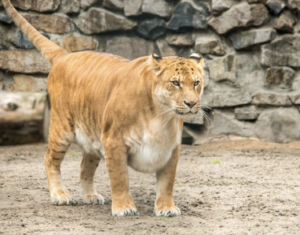
Another uncommon though desirable crossbreed is between lions and tigers. While not many will think that tigers and lions could mate, they can also have intriguing offspring. Hybrids between lions and tigers have become a type of prize animal sold for massive amounts, spawning zoo attractions, and are called ligers or tigons depending on the male and female parents.
How Can Cross Breeding Wild Harm an Animal?

To understand how can cross breeding wild harm an animal, here is an example of lions and tigers.
Tigons or Ligers are created when tigers and lions cross and create hybrids. However, the term used to refer to or identify them will vary based on the hybrid’s father and mother.
When naming a hybrid, you list the father’s species first. Therefore, a Tigon refers to a hybrid between a male tiger and a female lion, whereas a Liger refers to a hybrid between a male lion and a female tiger.
Nonetheless, there are several distinguishing characteristics and unique marks between ligers and tigons. These distinctions result from the mating partners. In other words, the parentage of the father and mother determines the features of the resultant hybrid.
Still, some people will argue that mating between a lion and a tiger is artificial. Hence, the offspring isn’t a natural species. This can be true because artificial mating results in undesirable traits, which could be unnatural and tragic. Often, these hybrids suffer genetic abnormalities, which cause high mortality rates at a very tender age.
Why Does Cross-breeding Make an Animal Sterile

Crossbreeding makes animals sterile. Hybrid animals can mate, but they cannot create babies. Mules are the offspring of a female horse and a male donkey, but two mules cannot produce another mule.
When chromosomes mix with the sex cells, babies are produced. Hybrid animals are infertile because the mixture and exchange of genetics from different species cause malfunctions in the chromosomes, meaning they do not have sex cells.
Surprisingly, some hybrids like ligers can have babies; however, they complicate the biological logic. This is because the product of two different species should be infertile. But, this isn’t the case for ligers. Because of this, scientists are undergoing discourse to this day to identify exactly what makes a species in the first place.
Why Can Dogs Crossbreed Easily and Other Animals Cannot?

Dogs are the most common example of animals breeding with other species because their genetics are distinct. Even though different dog breeds have distinct looks, appearances, and capabilities, their genomes remain unchanged. Hence they can easily crossbreed.
Crossbred dogs are popular because they develop hybrid vigor while retaining their unique looks.
You can breed two different types of dogs or even with other animals like coyotes to produce a hybrid dog.
There are several advantages of breeding different species of dogs, including
- Great Pets: Hybrid dogs learn quickly and are not timid when socializing.
- Unique Look: Hybrid dogs are always different from the previous ones. It is tough to get similar hybrids unless the mates are still the same.
- Increased Vigor: Crossbreeding dogs reduces the likelihood of having pre-existent genetic problems and diseases, thus making a more vital vigor.
Some disadvantages of crossbreeding dogs are:
- High delivery risk: Breeding different types of dogs can cause complications during delivery. If a stud is from a giant dog family, it poses delivery risks because a bitch from a small dog family will have difficulty delivering and may require a C-section.
- Health complications: Crossbreeding can cause some health problems that are hereditary from one generation to another. Epilepsy, kidney problems, and hip dysplasia are one of the most common diseases suffered by dogs.
Frequently Asked Questions
Is It Possible To Breed Other Animals?
Yes, is it possible to breed other animals that belong to different species depending on their genetic diversity. However, they may not always produce natural results and crossbreeds are often sterile.
What Is The Rarest Animal Hybrid?
A Jaglion is one of the rarest hybrid animals out there. It is a cross between a male jaguar and a female lion and only 1-2 jaglions exist in the entire world.
Can Humans Sperm Fertilize A Pig?
No, human sperm cannot fertilize a pig. There’s a large number of genetic differences between the two species alongside a varying number of chromosomes which leads to this incompatibility.
Conclusion For Can You Breed Different Animals?

Is Animal breeding with other animals possible? As you’ve read, yes. But remember, some crossbreeds might have reduced survival rates owing to poor immunity or other health complications resulting from a clash in their genetic makeup.
Therefore, before breeding animals, it is best to acquire all the necessary breeding information to ensure a successful and healthy offspring.
You will also like:
For more information about Cross Bred Animals, check out the video below:
Cats and rabbits have both been domesticated and have been kept as house pets for multiple generations. With their sizes being relatively similar, both mammals are known for their energetic, jumpy, and downright cute behavior. This begs the question, can a cat breed with a rabbit?
No, a cat cannot breed with a rabbit as it is genetically impossible. Rabbits have 44 chromosomes and cats have 38 which means that they cannot produce offspring under normal, natural circumstances.
Continue reading to discover what inquiring minds need to know– are your household pets, particularly your cat (Felis catus) and rabbit (Oryctolagus cuniculus domesticus) capable of mating to create “cabbits”?
Other articles you would like: Common Stray Cat Breeds and Animals That Breed a Lot
Can Cats Breed With Rabbits?

The short answer is: No, a cat breeding with a rabbit is genetically impossible.
While crossbreeding between certain animals is possible, rabbits and cats are too different on a genetic level to mate and reproduce a hybrid species. Even as science has come a long way and genetic engineering has made what was once impossible in nature possible within the confines of a lab, rabbits have 44 chromosomes, and cats have 38.
This makes cat-rabbit offspring one-hundred-percent impossible.
In 2002, Chinese scientists conducted a scientific experiment in which they attempted to use rabbits as surrogates for panda embryos. Of the 2300 embryos implanted, none resulted in a successful pregnancy.
As a secondary part of the experiment, scientists then impacted panda-rabbit hybrid embryos and cat-rabbit embryos into 21 different cats. Just like in the first portion of the experiment, the embryos were rejected, and none of them resulted in a successful pregnancy.
This successfully highlights the fact that these two species are incapable of breeding with each other even in lab conditions.
Mating Rituals and Reproductive Systems
While cats and rabbits can attempt to mate, it is rare because the species have very different mating rituals. In the wild, cats would naturally be considered predators, and rabbits would be their prey.
Even if the two species did manage to mate, the genetic codes between the sperm and the egg are too different and would give conflicting instructions to the embryo. As a result, the cells would die early.
The reproductive system is also not compatible between the two species. The gestation period in cats is different than in rabbits. Cats have a roughly two-month pregnancy term, and rabbits have a much shorter gestation period at roughly thirty-five days.
Digestive Systems
Cats and rabbits have vastly different digestive systems, too. Most of these differences are because rabbits are herbivores and cats are carnivores.
Cats have a short gut and cannot digest plant materials. While you may have seen your cat eat grass or munch on household plants, chances are they eventually threw up, or the plants passed through completely undigested.
Rabbits are herbivores and have longer digestive tracts. Their stomachs contain an enzyme that allows them to digest plant cellulose, so by the end of their tract, their stool has been digested twice.
So, to summarize, here are some of the differences between rabbits and cats which is why a cat cannot breed with a rabbit:
| Property | Cat | Rabbit |
| Diet Type | Carnivore | Herbivore |
| Chromosomes | 38 | 44 |
| Gestation Period | 63-65 days | 28-35 days |
| Food Chain | Predator | Prey |
Popular “Cabbit” Myths and Claims
The myth of the “cabbit” has been around for centuries, though none of these myths have ever been proven to be true. Cats and rabbits may be of similar size, but they are not compatible on a genetic level and would not be capable of producing offspring together.
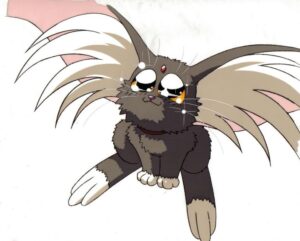
Despite this, the appeal of a cabbit has made its way into the media. A cabbit was even a featured character in the Japanese anime and manga series, Tenchi Muyo!
Cabbits were also mentioned in a book by Michael Cabon. No one has been officially credited with the concept of a cabbit, but it has been a popular myth for quite some time, dating back centuries.
Once, for April Fool’s, a paper ran a fake advertisement featuring a tiger-rabbit, but naturally, most people that picked up the paper on April 1st were fully aware it was false and were in on the joke. So, just like humans can’t breed with other animals, a cat and a rabbit seem to fall in a similar accord as well.
The Tale of the Tailless Cat – An Actual Cabbit?
The Manx cat is a breed of domestic cat (Felis cactus) that is born without a tail, or in many cases, these cats will have a significantly shortened tail. The Manx breed, first discovered on the Isle of Man, once even entertained a humorous and scientifically impossible theory that the tailless cat was a result of cats mating with rabbits.
The theory was documented in 1845 by Joseph Train, who claimed that this breed was a result of male buck rabbits cross-mating with female cats. It was eventually crushed once it was discovered that their tails, or lack thereof, are a natural-occurring genetic mutation.
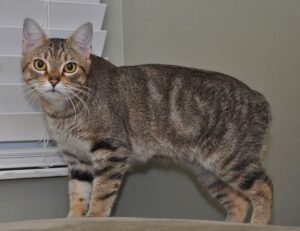
No rabbit genes have ever been identified in a Manx. The Manx-cabbit is nothing but a myth and a fun bit of British folklore.
In most scenarios where people claim to have proof or photographic evidence of some kind of a cabbit, they are related to the tailless Manx cat. In the late 70s and early 80s, “cabbits” made an appearance twice on Johnny Carson’s “The Tonight Show,” but these were likely Manx cats.
In 2000, the Jet City Maven came clean about a 49-year-old article about a cabbit in Canada that had been picked up and printed in several other publications. In any scenario, there has never been any DNA proof confirming the existence of a cabbit.
The Domestication and Breeding of Cats (and Rabbits!)

Humankind’s fascination and appreciation for animals has been around for nearly as long as mankind itself. Primitive humans studied animals closely and imitated their unique traits.
In ancient times, some animals were worshiped as part of religious sacrifices or considered to be deities or “God-like” with magical powers. One of the most well-known ancient civilizations known to have a deep appreciation of cats was the ancient Egyptians.
Based on archaeological finds and scientific studies of our ancient world, cats are known to be indigenous to Egypt. Exciting new studies and discoveries are being made every day as technology advances and resources improve. Some archaeological discoveries show evidence of early cats in Persia and Nubia.
However, there are no competing theories or evidence to suggest that cats may have originated elsewhere. Ancient Egyptians unleashed cats in their households to eat snakes, mice, and vermin to help protect their home and grain stores, and over time they eventually became domesticated.
The two original cat breeds of ancient Egypt are known to have been the wild cat (Felis chaus) and the African wildcat (Felis silvestris lybica). As these two breeds became domesticated, they were eventually bred together to form a new species that still exists today, the modern-day Egyptian Mau.
Most living cats all over the world can trace their ancestry back to ancient Egyptian cats and the Egyptian Mau, which is also the Egyptian word for cat. The modern-day domesticated cat has a much different temperament and appearance from its Egyptian ancestors, the wild cats.
Cats today have evolved to be smaller, more colorful, less muscular, and more tolerant of humans, resulting from a change in their domesticated lifestyle versus the wild.
The Evolutionary History of Rabbits
Domestic rabbits are part of the lagomorph family and are descendants of the European hare. Not a lot is known about the origins of lagomorphs, but it is believed that this subspecies originated either in Asia or India.
Today there are 110 known subspecies, of which 42 are rabbit species. If rabbits had any chance of crossbreeding with another species, it would likely be within its subspecies families, such as a hare or a pika. There are also many similarities between rodents and rabbits.
However, the most distinct difference is that rabbits have four incisors, and rodents have only two. Rodents can also be both carnivores and herbivores and have the ability to digest plant material.
Rabbits have been domesticated since the 19th century and similar to cats, can be litter trained. The popularity of keeping rabbits as household pets skyrocketed in the late 1980s, and nowadays are fairly easy to adopt from your local pet store. However, not all veterinarians are familiar with rabbits, and you may need to seek care from exotic pet veterinarians.
Animals That Can Crossbreed

Similar species of animals can hybridize, but it’s not without risks. In most cases, their offspring will be sterile or stillborn.
Popular Species That Have Crossbred
- Cats and Wildcats
- Horses and Donkeys crossbreed to produce Mules
- Zebras and Donkeys
- Wolves and Dogs
- Rat and Mouse
One of the most common crossbreeds is the mule. Bred for the optimal characteristics of both a horse and donkey, they’re exceptional workers, if not stubborn. However, mules can’t produce offspring.
However, before you go out picking an animal for yourself, make sure that are equipped with all the knowledge that you require such as their dietary habits and general demeanor. And, even then, always source responsibly from a legit breeder to avoid any trouble.
Frequently Asked Questions
Can A Cat Impregnate A Rabbit?
No, a cat cannot impregnate a rabbit. This is because they have an extreme amount of genetic differences and are of different species which leads to them not being able to breed.
Is A Cabbit A Real Animal?
No, a cabbit is not a real animal. Referred to as the offspring of a rabbit and a cat, a cabbit is only mentioned in folktales and rumors and has no place in actual science.
What Does A Cabbit Look Like?
A cabbit will contain some of the features of a cat and a rabbit. While not existing in real life, the species can inherit primary traits from both a cat and a rabbit to form highly energetic, jumpy, and cute offspring!
Conclusion For Can a Cat Breed With a Rabbit?
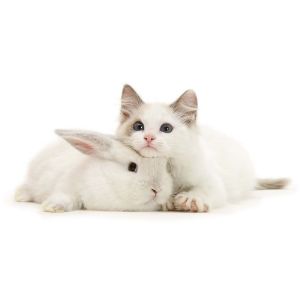
While the ancestry, evolution, domestication, and even the myths surrounding both cats and rabbits are certainly rich and fascinating facts, both species remain distinctly unique and separate.
One thing’s for sure: we’re certainly not getting any real cabbit offspring anytime soon.
You will also like:
- Russian Blue Cat Breeders in the United States
- Bengal Cat Breeders in California
- Animal Breeding For Disease Resistance
For more information about Cats and Rabbits, check out the video below: